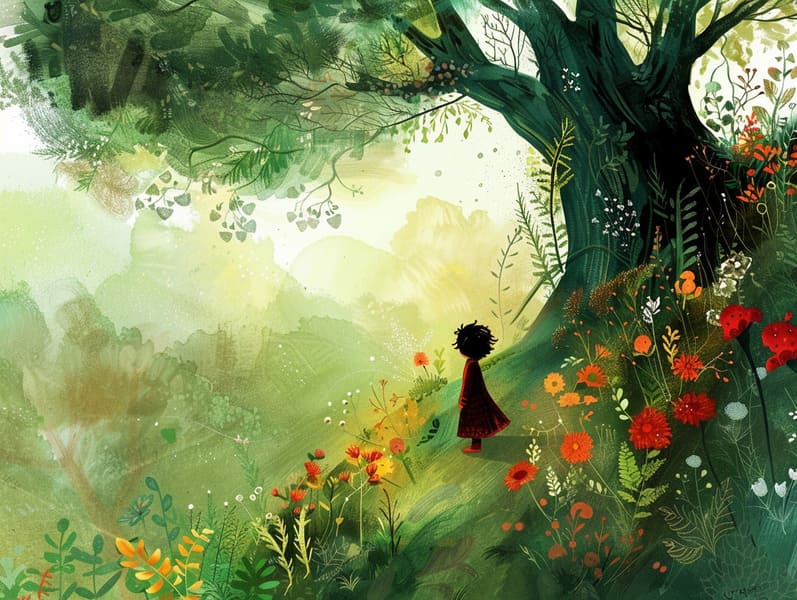
Best fairy tales have deep roots. These tales have been shared from one generation to the next millennia before they were ever transcribed. They arose from a variety of traditions, including African traditions. They were initially passed along among grown-ups, often carrying themes and messages aligned with the societal norms and beliefs of the time.
The Grimm brothers, Jacob and Wilhelm Grimm, were among the first to assemble many of these beloved narratives. Their published works, "Grimm's Children's Stories," included tales like "Ashenputtel," "The Bread Crumb Trail," and "Little Snow White," which have since become hallmarks in the world of iconic fairy tales. Similarly, Hans Christian Andersen's fanciful narratives, such as "The Story of the Little Mermaid," and "The Duckling that Could," have enchanted hearts worldwide, ensuring their place in the pantheon of famous fairy tales.
Though they are centuries old, classic fairy tales remain as impactful as ever, especially as bedtime stories for kids. These delightful tales are now available in many formats, including richly illustrated books, whimsical animations, and digital storybooks.
Their ongoing significance can be linked to several captivating elements:
Important Morals: Timeless fairy tales often whisper important moral lessons. Tales like "The Wolf and the Liar" teach the importance of truth, while "The Story of the Tortoise and the Hare" point out the virtues of steadfastness and unassuming nature. These narratives offer children clear distinctions between correct and incorrect, shaping their moral compass in a soft yet meaningful way.
Warmth and Understanding: Ancient fairy tales frequently include heroes facing difficulties and adversities, encouraging kids to empathize with their struggles and support their triumphs. For instance, "Beauty and Her Beast" demonstrates the benefit of seeing beyond the surface to acknowledge the real character of a individual, nurturing compassion and discernment.
Cultural Awareness: Many traditional fairy tales are steeped in the cultural contexts from which they developed. Understanding these fairy tales can provide fascinating glimpses into different social structures, advancing a sense of cultural respect and acknowledgment.
Creativity and Fantasy: The mythical elements in ancient fairy tales—spells and potions—kindle children’s fantasies. These narratives transport readers to otherworldly realms, enhancing creative dreams and a sense of marvel that continues a lifetime.
Ancient fairy tales are not only delightful but also educational. They provide mesmerizing tools in enhancing various thinking and feeling skills in the young. When ancient fairy tales are told out loud, they foster linguistic abilities by showing new terms and meanings and complex sentence structures. This practice also advances listening abilities and attentiveness, as children focus on every detail, enthusiastic to see what happens next.
Furthermore, examining the themes and characters of timeless fairy tales can strengthen thinking skills and thought processes. Young ones are led to discern patterns, predict happenings, and realize cause and effect. These reflections also facilitate the young verbalize their thoughts and feelings, adding to their emotional intelligence.
In today’s modern era, the abundance of digital storybooks has made these stories more accessible than ever. Internet sites and digital apps make available wide arrays of ancient fairy tales that can be explored or listened through anytime, anywhere. Fairy tales recited are particularly sought after, presenting an immersive method for young readers to engage with these alluring stories. Audiobooks and read-out-loud videos bring characters and settings to life, often paired with fantastical music and musical scores that improve the storytelling experience.
The enduring charm of timeless fairy tales lies in their ability to shift to present eras while preserving their main lessons. Contemporary adaptations of these tales often highlight more varied protagonists and modern settings, making them understandable to today’s audience. However, the main ideas of braveness, compassion, and integrity remain unchanged, continuing to influence young listeners of all ages.
Fairy tales also offer a sense of solace and knownness. They allow a neat narrative with a distinct beginning, middle, and end, often winding up with the wrap-up of conflicts and the triumph of truth over falsehood. This uniformity can be reassuring for children, affording a sense of solidity in an shifting world.
Traditional fairy tales continue to fascinate and instruct new generations, maintaining their spell and pertinence in modern society. As children's bedtime classic fairy tales stories, they present a perfect blend of fantasy and learning, cultivating moral values, empathy, and creativity. The abundance of digital storybooks and the sought after status of fairy tales read aloud confirm that these old stories remain acquirable to new generations.
By safeguarding and sharing these fairy tales, we continue to revere the rich tapestry of narrative artistry and cultural heritage. Whether you are discovering a gorgeously illustrated book, accessing a internet library, or listening to an audiobook, the radiance of Grimm's fairy tales is always within reach. These fairy tales emphasize of the unceasing ability of narratives and its ability to bring us together across eras and regions.
Be it you are enjoying a richly illustrated book, discovering a digital collection, or playing an spoken story, the grandeur of Grimm's fairy tales is always within reach.
These narratives illustrate of the invariable essence of tales and its ability to bond us across epochs and places, weaving a spell that enchants and educates alike.